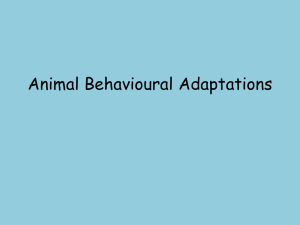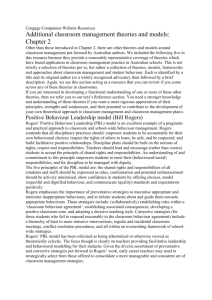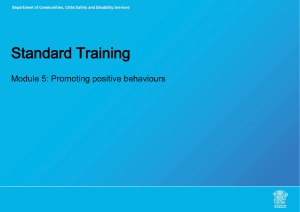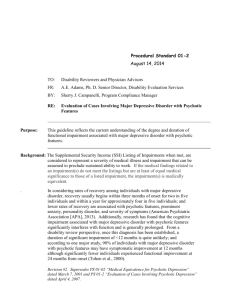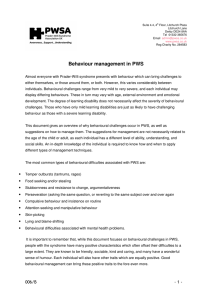Mental health and challenging behaviour affecting people with ID
advertisement
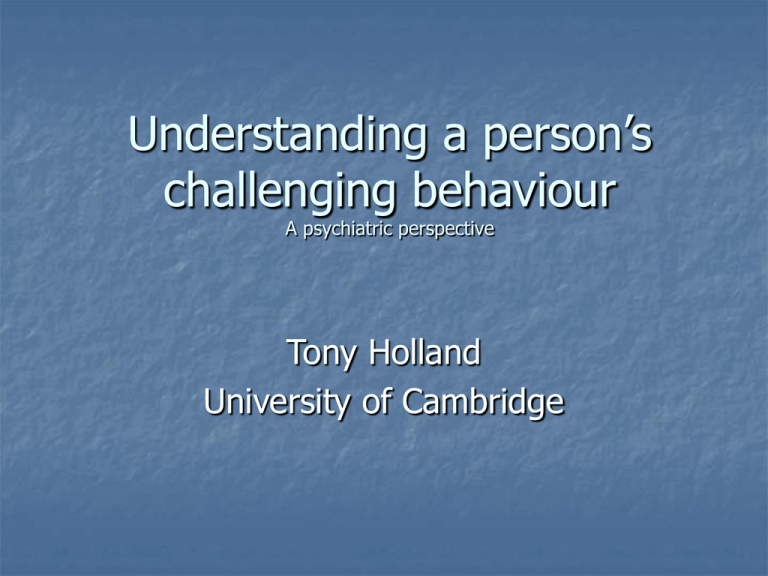
Understanding a person’s challenging behaviour A psychiatric perspective Tony Holland University of Cambridge Overview The term challenging behaviour is a ‘descriptive’ term – it does not imply any understanding as to the causes of such behaviour; A holistic approach is clearly required – that implies a bio-psychosocial model of understanding; Key to any successful intervention is the formulation Different theoretical perspectives Importance of matching observations and data collect to theory Interventions based on established efficacy Where medication is used it is on the basis of a clear hypothesis that the challenging behaviour may wholly or partly be related to the presence of a co-morbid disorder known to respond to such medication Anticonvulsants (epilepsy) Anti-depressants and mood stabilising medications (depression, bipolar disorder, anxiety) Anti-psychotic medication (psychotic illness) Treatments for physical illness, pain etc Complexity of developmental disabilities Aetiology and developmental trajectories: Nature and extent of impairment and associated disabilities; Associated ‘developmental’ impairments Associated co-morbidities Personality Autism spectrum conditions Neurodevelopmental syndromes Sensory Physical health Mental health Past and present life circumstances Individual differences and gene/environment interactions Complexity of challenging behaviour and psychiatric disorder Terminology Conceptual models Descriptive Aetiological Applied behavioural analysis Acquired disorders (psychiatric; medical) Developmental Systemic factors Family and carer responses ‘Emotional’ environments Matrix Biological Developmental Psychological Environmental Onset and continuation of ‘behaviour’ and/or abnormal mental state Predispose Precipitate Maintain Triggering events Wider physical and emotional environment Setting events Applied behavioural analysis Delayed or atypical development Autism spectrum conditions Behavioural phenotypes Co-morbidities Physical illness Psychiatric illness Sequelae of abuse ASSESSMENT PROCESS DATA COLLECTION AND ORGANISATIONAL PHASE Identification of index problems Data collection History, mental state and physical examination from patient and informant For example: Onset of new problem behaviours Change in general well-being Loss of skills Deterioration in frequency/severity of long-standing behaviours INVESTIGATION & INTERVENTION PHASE Final formulation Initial formulation Intervention & evaluation Investigations & observations e.g., ABC charts, psychometric assessments, monitoring of mental state, blood tests, scans Differential diagnosis Identification of possible factors that predispose, precipitate and/or maintain behaviours and/or abnormal mental state. Specific interventions & treatments Monitoring outcomes Developmental psychopathology Co-morbid diagnoses (if present) Identified functions of behaviours aetiological and maintaining factors Approaches to intervention Emerson, Hatton et al, 1998 Formulation of the problem should reflect contemporary scientific knowledge Empirical testing of hypotheses Review and revision of ‘model’ in the light of data collected Intervention based on a) understanding of individual; b) scientific evidence of effectiveness of proposed intervention Scientifically sound evaluation of outcomes Behaviour in PWS Population-based study Prevalence (%) of specific behaviours (n=65) Definite sometime none Excessive eating 78 21 1 Obsessional 70 23 7 Tempers 67 27 6 Skin picking 59 22 19 Mood swings 38 19 43 Mechanisms linking the genotype to the ‘PWS behavioural phenotype’ Propose that different mechanisms link genotype to phenotype in PWS: Eating disorder – direct effect of dysregulation of expression of paternally expressed maternally imprinted gene; Repetitive and ritualistic behaviours – arrested development – inability to switch tasks leads to temper outbursts; Mood disorder- shift in liability threshold in PWS Psychotic illness excess expression paternally imprinted maternally expressed gene Number of people Graph to show the number of people with at least one psychotic symptom (all ages 18years+) 100 90 80 70 60 50 40 30 20 10 0 No psychotic symptoms 74 Any psychotic symptom 10 12 19 Deletion Disomy Genetic subtype Fishers Exact test; p<0.001 Management of CB affecting people with PWS Understand the ‘mechanisms’ that underpin the behaviour; Different for different behaviours or mental illnesses; Eating Repetitive Mood disorder Effective intervention requires combining knowledge about the individual and the syndrome Examples Mr H with ASC – increasing aggressive behaviour over many years starting aged 13. Severe bipolar disorder and psychotic illness – CB resolved with treatment of his illness; Mr R with moderate LD - arrested by the police for indecent exposure – undressing part of a complex partial seizure; Ms C with mild LD and ASC – periodic problematic behaviour mainly at times of unexpected change when associated with severe anxiety – various strategies including SSRI for anxiety.



